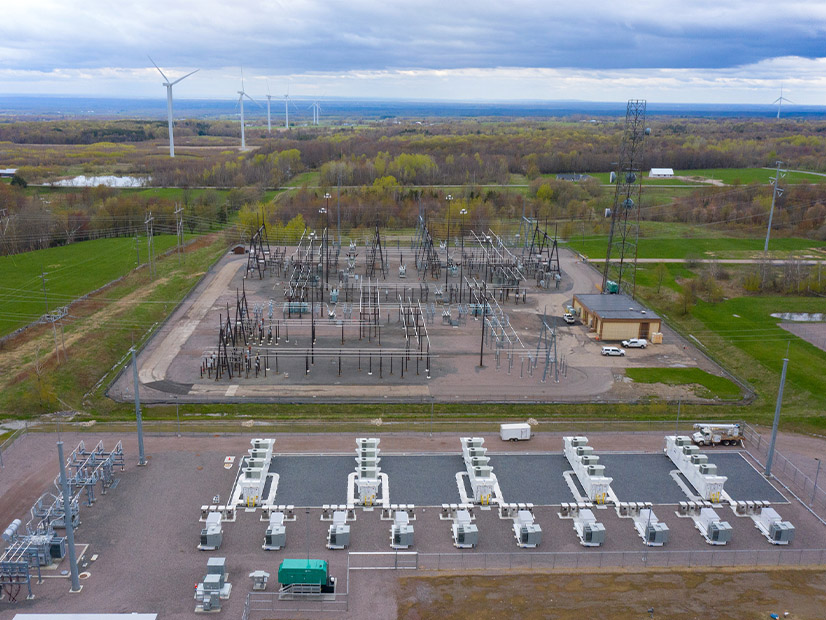A long shadow was cast over 2023 by the final days of the preceding year as the December 2022 winter storm, known as Elliott, brought the PJM grid to the brink, ushering in a year of stakeholder discussions to shore up the issues that the storm revealed.
While the RTO avoided the widespread outages seen in other regions during the storm, 46 GW of generation went on forced outage — prompting control room operators to issue a voltage-reduction alert and prepare for the possibility that load shedding might be required. Once the dust had cleared and the performance shortfalls for underperforming generators had been calculated, market sellers faced $1.8 billion in penalties.
In the months following the storm, PJM and stakeholders discussed concerns that capacity market structures had only narrowly avoided outages and the penalties meant to incentivize performance might prove punitive to the point of causing a surge in retirements and deceleration in new entry.
The largest set of changes drafted this year are a pair of filings pending before FERC, encompassing components of proposals stakeholders drafted through the Critical Issue Fast Path (CIFP) process the PJM Board of Managers launched in February. The proposed market design would leave much of the Reliability Pricing Model (RPM) design intact while revising the Capacity Performance construct, market seller offer cap (MSOC) calculation, risk modeling and generation accreditation. (See “PJM Steams Ahead with CIFP Filing Timeline After FERC Deficiency Notices,” PJM MIC Briefs: Dec. 6, 2023.)
The first of the two proposals (ER24-98) would effectively lower the maximum CP penalties a resource can face in a year by basing the penalty calculation on the Base Residual Auction (BRA) clearing price, rather than the net cost of new entry (CONE). It would also limit bonus payments, which are derived from penalty payments, to capacity resources, making energy-only generation ineligible.
The filing would also revise the MSOC calculation to allow generators to include more cost of risk in their offers even when their net avoidable-cost rate (ACR) is zero or negative.
The second filing (ER24-99) includes accrediting all resources under a marginal effective load-carrying capability (ELCC) framework, which PJM said would reflect the actual capacity value that resources provide. The filing also would increase the granularity of risk modeling, tighten testing requirements for capacity resources and revise components of the fixed resource requirement (FRR) framework to align with the RPM.
After the commission issued deficiency notices on both filings in November, PJM said it believes there remains a pathway to receiving approval for the market changes in time for them to be implemented for the 2025/26 BRA, which is scheduled to be conducted in June. The notices reset the 60-day timeline for the commission to issue an order on the proposals to two months after PJM’s responses; for ER24-98 that means an order by Feb. 6, and by Jan. 30 for ER24-99.
Throughout the four CIFP phases, PJM and stakeholders developed 20 proposals ranging from revising the CP penalty structure to major reworks of the capacity market, such as shifting to a seasonal construct or paying resources for each hour they are able to offer their capacity into the energy market. None of the packages ultimately received a recommendation from the Members Committee in an Aug. 23 vote. (See PJM Stakeholders Vote Against All CIFP Proposals.)
The board also sought to reduce the risks generators face in the capacity market by tightening the triggers to initiate a performance assessment interval (PAI), which the RTO argued in the CIFP filings would maintain an incentive to perform even with a lower maximum annual penalty. The commission approved PJM’s request on July 28. (See FERC Approves PJM Change to Emergency Triggers.)
The new rules add a requirement that a primary reserve shortage be in place paired with any of the following: a voltage reduction warning and reduction of noncritical plant load; manual load dump warning; maximum generation emergency action; or curtailment of nonessential building load.
In directing that the filing be made, the board chose half of a proposal endorsed by the MC in May, rejecting a stakeholder call for a reduction in the nonperformance penalties by basing the calculation on the BRA clearing price. While the annual stop-loss would be tied to capacity prices under the CIFP filing, the penalty rate would continue to be derived from net CONE. (See PJM Board Rejects Lowering Capacity Performance Penalties.)
Settlement Reduces Elliott Penalties
While discussions on how to change PJM’s markets went on throughout the year, market sellers that underperformed during Elliott negotiated with PJM to reach a settlement to reduce the $1.8 billion in penalties they faced.
An agreement was reached in October to reduce the total sum to $1.25 billion, and FERC granted its blessing last month, resolving the bulk of the 15 complaints filed against PJM over its assessment and application of the penalties. (See FERC Approves Settlement Reducing PJM Penalties for Elliott Underperformance.)
In a concurrent order, FERC rejected a complaint from Energy Harbor arguing that PJM had not properly accounted for a maintenance outage that partially reduced the output of its Sammis generator. The RTO argued that the generator also experienced a forced outage that could account for the entirety of the facility’s performance shortfall and therefore the maintenance outage was not an excuse for its underperformance.
The commission is still considering a second complaint not fully resolved by the settlement, an argument from the East Kentucky Power Cooperative (EKPC) that basing the penalty rate and annual stop-loss on net CONE, rather than the BRA clearing price, results in the potential for penalties being higher than the revenues a resource can earn in the market and is not just and reasonable.
PJM also sought to reduce the financial shock of the penalties by creating a new payment option that allows the penalties to be paid over the course of nine months, rather than by the end of the delivery year, at the cost of being subject to interest. Penalty payments are due by the end of the delivery year in which they are assessed under the standard schedule. The commission approved the alternative on April 7, and about 30% of market sellers saddled with penalties chose the longer timeline. (See “FERC Approves Alternative Billing Schedule,” PJM: Elliott Nonperformance Penalties Total More Than $1.8B.)
New Stakeholder Groups Continue Reliability Discussions
Stakeholders have also launched three groups to investigate further changes to PJM’s markets and planning processes aimed at reducing reliability risks posed by shocks to the grid, such as winter storms, and the balance between generation deactivations, new resource entry and load growth.
The Deactivation Enhancements Senior Task Force and Reserve Certainty Senior Task Force were both formed by the Markets and Reliability Committee in September, and the Long-Term Regional Transmission Planning Workshop began its work in July. (See PJM MRC/MC Briefs: Sept. 20, 2023.)
The RCSTF was created with a wide-ranging issue charge intended to address any deficiencies stakeholders identify in the near, intermediate and long terms. The areas the group is tasked with investigating include reserve performance and penalties for not meeting obligations when called upon; ensuring that market offers reflect actual resource capability and fuel procurement; how reserves are deployed and in what quantity; requirements for a resource to provide reserves; and how to incentivize resource flexibility. Thus far the group has been focused on education provided by PJM and the Independent Market Monitor around how reserve resources fit into the RTO’s markets.
The DESTF is charged with considering changes to the timeline on which generators are required to notify PJM of their intent to deactivate and how generators that agree to retire past their desired offline date are compensated under reliability-must-run (RMR) contracts. During discussions around the task force’s creation, PJM and the Monitor said that the number of large generators deactivating is likely to accelerate over the coming years and that the RTO’s mechanisms for replacing the energy provided by retiring resources would function better with additional notice. Generation owners are only required to provide 90 days’ notice of their intent to cease operations.
The task force began the interest identification process during its Dec. 8 meeting, with stakeholders detailing goals of ensuring that deactivation notices provide adequate time for solutions to be implemented and compensation is provided for all services resources provide.
PJM has been forming a proposal during LTRTP meetings to create a 15-year planning horizon that would forecast the future balance between load and generation under three scenarios: a base case focused on reliability needs and near-term solutions that can resolve them, and two looking at state legislation and objectives that may affect load — such as electrification — and generation, such as environmental policies prompting deactivations or renewable development.
New Generation Interconnection Process Intended to Clear Projects Faster
PJM has completed the process of sorting 616 generation interconnection requests into two transitional queues, one of the first steps in the transition from a first-come, first-served serialized study process to the clustered approach FERC approved in December 2022. (See FERC Approves PJM Plan to Speed Interconnection Queue.)
In a Dec. 21 announcement of the milestone, PJM said the projects were evenly split between the expedited process, or “fast lane,” and first transition cycle (TC1). The fast lane is designed to allow projects requiring relatively smaller grid upgrades to be approved quicker, with final documentation expected through this year. Studies of projects in TC1 may be complete in 2025.
PJM said it anticipates studies being completed on about 300 projects in 2024, allowing 26,000 MW of nameplate capacity to move another step closer to construction. By mid-2025, it expects an additional 46,000 MW to have completed the new process.
The transition to the new study process began in mid-July when PJM opened a 60-day window for projects to meet readiness requirements, namely showing that they have site control and making deposits towards the study costs. The system of increasingly large deposits and requirements on developers as they move through the study process is meant to reduce the number of speculative projects to allow PJM staff to focus on those most likely to reach commercial operation.
Half of the 72 GW in projects expected to have their studies completed through 2025 are solar, growing to 65% when solar-and-storage hybrids are included. Standalone solar makes up a further 12.7% of project proposals, followed by offshore wind at 8.2% and onshore wind at 6.1%. Merchant transmission contributes another 5.7%, and 1,647 MW of natural gas adds 2.3%.
The amount of time to get a signed generation interconnection agreement has been cited as one of the key hurdles in bringing more capacity online, one of the challenges PJM identified in its February “4R’s” white paper. The report stated that the pace of new generation development is not set to keep pace with load growth, particularly from data centers, and generation deactivations. (See PJM Whitepaper to Highlight Future RA Concerns.)
Developers at a Solar Focus conference in November said the prospect of a project proposed today not having its study initiated until 2026, and the in-service date being as far out as 2030, has made grid-connected projects a hard sell. When looking to site solar projects in the PJM footprint, Steve Swern of Sol Systems said, multiple strategies are considered, including bypassing the queue by approaching utilities to connect to their distribution grids. (See Solar Developers Sing Mid-Atlantic Interconnection Blues.)
PJM has argued that the issues slowing renewable development go beyond the interconnection queue, stating that about 40 GW of projects have cleared the queue but have yet to be built, often because of issues with siting and permitting, procurement timelines and financing.
During a Dec. 24 Interconnection Process Subcommittee meeting, PJM’s Jonathan Thompson said projects that have been placed in the expedited queue following the completion of their readiness studies can still be shifted to TC1 if the short-circuit, stability or feasibility analyses determine that the project will require grid upgrades larger than $5 million.
Thompson told stakeholders that PJM will carry over the study deposits developers have already made to cover the initial deposits under the new process, but additional deposits will be required further into the process.
PJM also introduced the Queue Scope tool, which allows users to explore the potential transmission upgrades needed to construct a generator at specific locations and how it might impact grid congestion.
Data Center Growth, Deactivations Create Need for New Transmission
One of the largest transmission buildouts PJM has seen was given the greenlight by the board last year to address 11,000 MW in generation deactivations and about 7,500 MW of new data center load in Northern Virginia, highlighting the potential impacts of the challenges that the new stakeholder groups intend to address. (See FERC Approves PJM RTEP Projects over State Protests.)
The estimated $5 billion package of transmission projects the board approved on Dec. 11 would build lines spanning Maryland, Pennsylvania, Virginia and West Virginia, with a particular focus on bringing power into so-called Data Center Alley, around Dulles Airport in Virginia, and into Baltimore, where the retirement of the Brandon Shores generator poses reliability risks. The Brandon Shores retirement also prompted the $796 million Grid Solutions Package as part of the Regional Transmission Expansion Plan projects the board approved in July. PJM expects to update stakeholders on the status of RMR discussions with Talen Energy, owner of Brandon Shores, in the coming months.
State consumer advocates said both the December and July RTEP approvals highlighted flaws with PJM’s planning processes, which they argue leave inadequate time for stakeholders and the public to understand and comment on the final projects before they are brought to the board. Dozens of residents from regions the transmission lines would pass through objected to the proposal, citing disruption of historic communities, agricultural land and nature preserves; the inclusion of greenfield components rather than utilizing existing rights of way; the cost to ratepayers; and the possibility that the project would support load growth through 2028 but prove insufficient should Data Center Alley continue to grow.
A pocket of data centers is also driving $579.5 million in transmission upgrades in Ohio, with an estimated consumption of about 3,000 MW. Unlike the projects in Virginia, the Ohio projects would affect infrastructure below the 500-kV threshold to initiate the competitive process for soliciting proposal designs. (See “Data Center Growth in Ohio Contributing to Nearly $600 Million in Transmission Upgrades,” PJM PC/TEAC Briefs: May. 9, 2023.)


